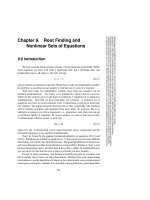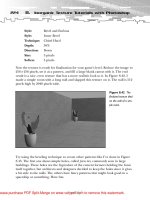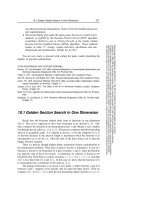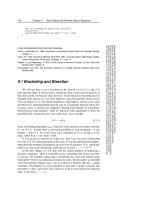Tài liệu Root Finding and Nonlinear Sets of Equations part 2 docx
Bạn đang xem bản rút gọn của tài liệu. Xem và tải ngay bản đầy đủ của tài liệu tại đây (119.28 KB, 5 trang )
350
Chapter 9. Root Finding and Nonlinear Sets of Equations
Sample page from NUMERICAL RECIPES IN C: THE ART OF SCIENTIFIC COMPUTING (ISBN 0-521-43108-5)
Copyright (C) 1988-1992 by Cambridge University Press.Programs Copyright (C) 1988-1992 by Numerical Recipes Software.
Permission is granted for internet users to make one paper copy for their own personal use. Further reproduction, or any copying of machine-
readable files (including this one) to any servercomputer, is strictly prohibited. To order Numerical Recipes books,diskettes, or CDROMs
visit website or call 1-800-872-7423 (North America only),or send email to (outside North America).
for (i=1;i<=ISCR;i++) printf("%c",scr[i][1]);
printf("\n");
printf("%8s %10.3f %44s %10.3f\n"," ",x1," ",x2);
}
}
CITED REFERENCES AND FURTHER READING:
Stoer, J., and Bulirsch, R. 1980,
Introduction to Numerical Analysis
(New York: Springer-Verlag),
Chapter 5.
Acton, F.S. 1970,
Numerical Methods That Work
; 1990, corrected edition (Washington: Mathe-
matical Association of America), Chapters 2, 7, and 14.
Ralston, A., and Rabinowitz, P. 1978,
A First Course in Numerical Analysis
, 2nd ed. (New York:
McGraw-Hill), Chapter 8.
Householder, A.S. 1970,
The Numerical Treatment of a Single Nonlinear Equation
(New York:
McGraw-Hill).
9.1 Bracketing and Bisection
We will say that a root is bracketed in the interval (a, b) if f(a) and f(b)
have opposite signs. If the function is continuous, then at least one root must lie in
that interval (the intermediate value theorem). If the function is discontinuous, but
bounded, then instead of a root there might be a step discontinuity which crosses
zero (see Figure 9.1.1). For numerical purposes, that might as well be a root, since
the behavior is indistinguishable from the case of a continuous function whose zero
crossing occurs in between two “adjacent” floating-point numbers in a machine’s
finite-precision representation. Only for functions with singularities is there the
possibility that a bracketed root is not really there, as for example
f(x)=
1
x−c
(9.1.1)
Some root-finding algorithms (e.g., bisection in this section) will readily converge
to c in (9.1.1). Luckily there is not much possibility of your mistaking c,orany
number x close to it, for a root, since mere evaluation of |f(x)| will give a very
large, rather than a very small, result.
If you are given a function in a black box, there is no sure way of bracketing
its roots, or of even determining that it has roots. If you like pathological examples,
think aboutthe problem of locating the two real roots of equation (3.0.1), which dips
below zero only in the ridiculously small interval of about x = π ± 10
−667
.
In the next chapter we will deal with the related problem of bracketing a
function’s minimum. There it is possible to give a procedure that always succeeds;
in essence, “Go downhill, taking steps of increasing size, until your function starts
back uphill.” There isno analogous procedure for roots. The procedure “go downhill
until your function changes sign,” can be foiled by a function that has a simple
extremum. Nevertheless, if you are prepared to deal with a “failure” outcome, this
procedure is often a good first start; success is usual if your function has opposite
signs in the limit x →±∞.
9.1 Bracketing and Bisection
351
Sample page from NUMERICAL RECIPES IN C: THE ART OF SCIENTIFIC COMPUTING (ISBN 0-521-43108-5)
Copyright (C) 1988-1992 by Cambridge University Press.Programs Copyright (C) 1988-1992 by Numerical Recipes Software.
Permission is granted for internet users to make one paper copy for their own personal use. Further reproduction, or any copying of machine-
readable files (including this one) to any servercomputer, is strictly prohibited. To order Numerical Recipes books,diskettes, or CDROMs
visit website or call 1-800-872-7423 (North America only),or send email to (outside North America).
a
b
(b)
x
1
efcx
1
d
ab
b
a
(c)
(d)
(a)
x
2
x
3
Figure 9.1.1. Some situations encountered while root finding: (a) shows an isolated root x
1
bracketed
by two points a and b at which the function has opposite signs; (b) illustrates that there is not necessarily
a sign change in the function near a double root (in fact, there is not necessarily a root!); (c) is a
pathological function with many roots; in (d) the function has opposite signs at points a and b, but the
points bracket a singularity, not a root.
352
Chapter 9. Root Finding and Nonlinear Sets of Equations
Sample page from NUMERICAL RECIPES IN C: THE ART OF SCIENTIFIC COMPUTING (ISBN 0-521-43108-5)
Copyright (C) 1988-1992 by Cambridge University Press.Programs Copyright (C) 1988-1992 by Numerical Recipes Software.
Permission is granted for internet users to make one paper copy for their own personal use. Further reproduction, or any copying of machine-
readable files (including this one) to any servercomputer, is strictly prohibited. To order Numerical Recipes books,diskettes, or CDROMs
visit website or call 1-800-872-7423 (North America only),or send email to (outside North America).
#include <math.h>
#define FACTOR 1.6
#define NTRY 50
int zbrac(float (*func)(float), float *x1, float *x2)
Given a function
func
and an initial guessed range
x1
to
x2
, the routine expands the range
geometrically until a root is bracketed by the returned values
x1
and
x2
(in which case
zbrac
returns
1
) or until the range becomes unacceptably large (in which case
zbrac
returns
0
).
{
void nrerror(char error_text[]);
int j;
float f1,f2;
if (*x1 == *x2) nrerror("Bad initial range in zbrac");
f1=(*func)(*x1);
f2=(*func)(*x2);
for (j=1;j<=NTRY;j++) {
if (f1*f2 < 0.0) return 1;
if (fabs(f1) < fabs(f2))
f1=(*func)(*x1 += FACTOR*(*x1-*x2));
else
f2=(*func)(*x2 += FACTOR*(*x2-*x1));
}
return 0;
}
Alternatively, you might want to “look inward” on an initial interval, rather
than “look outward” from it, asking if there are any roots of the function f(x) in
the interval from x
1
to x
2
when a search is carried out by subdivision into n equal
intervals. The following function calculates brackets for up to nb distinct intervals
which each contain one or more roots.
void zbrak(float (*fx)(float), float x1, float x2, int n, float xb1[],
float xb2[], int *nb)
Given a function
fx
defined on the interval from
x1-x2
subdivide the interval into
n
equally
spaced segments, and search for zero crossings of the function.
nb
is input as the maximum num-
ber of roots sought, and is reset to the number of bracketing pairs
xb1[1..nb]
,
xb2[1..nb]
that are found.
{
int nbb,i;
float x,fp,fc,dx;
nbb=0;
dx=(x2-x1)/n; Determine the spacing appropriate to the mesh.
fp=(*fx)(x=x1);
for (i=1;i<=n;i++) { Loop over all intervals
fc=(*fx)(x += dx);
if (fc*fp <= 0.0) { If a sign change occurs then record values for the
bounds.xb1[++nbb]=x-dx;
xb2[nbb]=x;
if(*nb == nbb) return;
}
fp=fc;
}
*nb = nbb;
}
9.1 Bracketing and Bisection
353
Sample page from NUMERICAL RECIPES IN C: THE ART OF SCIENTIFIC COMPUTING (ISBN 0-521-43108-5)
Copyright (C) 1988-1992 by Cambridge University Press.Programs Copyright (C) 1988-1992 by Numerical Recipes Software.
Permission is granted for internet users to make one paper copy for their own personal use. Further reproduction, or any copying of machine-
readable files (including this one) to any servercomputer, is strictly prohibited. To order Numerical Recipes books,diskettes, or CDROMs
visit website or call 1-800-872-7423 (North America only),or send email to (outside North America).
Bisection Method
Once we know that an interval contains a root, several classical procedures are
available to refine it. These proceed with varying degrees of speed and sureness
towards the answer. Unfortunately,the methods that are guaranteed to converge plod
along most slowly, while those that rush to the solutionin the best cases can also dash
rapidly to infinity without warning if measures are not taken to avoid such behavior.
The bisection method is one that cannot fail. It is thus not to be sneered at
as a method for otherwise badly behaved problems. The idea is simple. Over
some interval the function is known to pass through zero because it changes sign.
Evaluate the function at the interval’s midpoint and examine its sign. Use the
midpoint to replace whichever limit has the same sign. After each iteration the
bounds containing the root decrease by a factor of two. If after n iterations the root
is known to be within an interval of size
n
, then after the next iteration it will be
bracketed within an interval of size
n+1
=
n
/2(9.1.2)
neither more nor less. Thus, we know in advance the number of iterations required
to achieve a given tolerance in the solution,
n =log
2
0
(9.1.3)
where
0
is the size of the initially bracketing interval, is the desired ending
tolerance.
Bisection must succeed. If the interval happens to contain two or more roots,
bisection will find one of them. If the interval contains no roots and merely straddles
a singularity, it will converge on the singularity.
When a method converges as a factor (less than 1) times the previousuncertainty
to the first power (asis the case for bisection), it is said toconverge linearly. Methods
that converge as a higher power,
n+1
= constant × (
n
)
m
m>1(9.1.4)
are said to converge superlinearly. In other contexts “linear” convergence would be
termed“exponential,”or “geometrical.” Thatisnottoo badatall: Linearconvergence
means that successive significant figures are won linearly with computational effort.
It remains to discuss practical criteria for convergence. It is crucial to keep in
mind that computers use a fixed number of binary digits to represent floating-point
numbers. Whileyour function might analyticallypass throughzero, it ispossible that
its computed value is never zero, for any floating-point argument. One must decide
what accuracy on the root is attainable: Convergence to within 10
−6
in absolute
value is reasonable when the root lies near 1, but certainly unachievable if the root
lies near 10
26
. One might thus think to specify convergence by a relative (fractional)
criterion, but this becomes unworkable for roots near zero. To be most general, the
routines below will require you to specify an absolute tolerance, such that iterations
continue until the interval becomes smaller than this tolerance in absolute units.
Usually you may wish to take the tolerance to be (|x
1
| + |x
2
|)/2 where is the
machine precision and x
1
and x
2
are the initialbrackets. When the rootlies near zero
you ought to consider carefully what reasonable tolerance means for your function.
The following routine quits after 40 bisections in any event, with 2
−40
≈ 10
−12
.
354
Chapter 9. Root Finding and Nonlinear Sets of Equations
Sample page from NUMERICAL RECIPES IN C: THE ART OF SCIENTIFIC COMPUTING (ISBN 0-521-43108-5)
Copyright (C) 1988-1992 by Cambridge University Press.Programs Copyright (C) 1988-1992 by Numerical Recipes Software.
Permission is granted for internet users to make one paper copy for their own personal use. Further reproduction, or any copying of machine-
readable files (including this one) to any servercomputer, is strictly prohibited. To order Numerical Recipes books,diskettes, or CDROMs
visit website or call 1-800-872-7423 (North America only),or send email to (outside North America).
#include <math.h>
#define JMAX 40 Maximum allowed number of bisections.
float rtbis(float (*func)(float), float x1, float x2, float xacc)
Using bisection, find the root of a function
func
known to lie between
x1
and
x2
. The root,
returned as
rtbis
, will be refined until its accuracy is ±
xacc
.
{
void nrerror(char error_text[]);
int j;
float dx,f,fmid,xmid,rtb;
f=(*func)(x1);
fmid=(*func)(x2);
if (f*fmid >= 0.0) nrerror("Root must be bracketed for bisection in rtbis");
rtb = f < 0.0 ? (dx=x2-x1,x1) : (dx=x1-x2,x2); Orient the search so that f>0
lies at x+dx.for (j=1;j<=JMAX;j++) {
fmid=(*func)(xmid=rtb+(dx *= 0.5)); Bisection loop.
if (fmid <= 0.0) rtb=xmid;
if (fabs(dx) < xacc || fmid == 0.0) return rtb;
}
nrerror("Too many bisections in rtbis");
return 0.0; Never get here.
}
9.2 Secant Method, False Position Method,
and Ridders’ Method
For functions that are smooth near a root, the methods known respectively
as false position (or regula falsi)andsecant method generally converge faster than
bisection. In both of these methods the function is assumed to be approximately
linear in the local region of interest, and the next improvement in the root is taken as
the point where the approximating line crosses the axis. After each iteration one of
the previous boundary points is discarded in favor of the latest estimate of the root.
The only difference between the methods is that secant retains the most recent
of the prior estimates (Figure 9.2.1; this requires an arbitrary choice on the first
iteration), while false positionretains that prior estimate for which the functionvalue
has opposite sign from the function value at the current best estimate of the root,
so that the two points continue to bracket the root (Figure 9.2.2). Mathematically,
the secant method converges more rapidly near a root of a sufficiently continuous
function. Its order of convergence can be shown to be the “golden ratio” 1.618 ...,
so that
lim
k→∞
|
k+1
|≈const ×|
k
|
1.618
(9.2.1)
The secant method has, however, the disadvantage that the root does not necessarily
remain bracketed. For functions that are not sufficiently continuous, the algorithm
can therefore not be guaranteed to converge: Local behavior might send it off
towards infinity.









